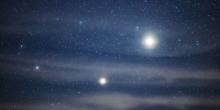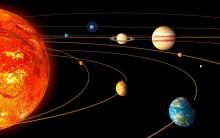Space science
Comet from edge of solar system killed the dinosaurs: Study
Sixty-six million years ago, a huge celestial object struck off the coast of what is now Mexico, triggering a catastrophic "impact winter" that eventually wiped out three-quarters of life on Earth, including the dinosaurs.
A pair of astronomers at Harvard say they have now resolved long-standing mysteries surrounding the nature and origin of the "Chicxulub impactor."
Incredible NASA illustration shows Venus volcano eruption (video)
Venus is the second planet closest to the Sun in our Solar System
Sky enthusiasts enjoy view of conjunction
Skygazers all around the world enjoyed the view of a lifetime on Dec. 21 night as two gas giants appeared very close together in the night sky.
"Skywatchers are enjoying a once-in-a-lifetime look at a close alignment of Jupiter and Saturn!" NASA said on Twitter.
Called the great conjunction, the rare sight occurred at about 18:20 UTC, according to timeanddate.com.
- Read more about Sky enthusiasts enjoy view of conjunction
- Log in to post comments
Jupiter and Saturn 'Great conjunction' on Winter Solstice
On 21 December 2020, the planets aligned, appearing closer than they have since the middle ages, in what is being called a 'Christmas kiss'
Jupiter & Saturn meet in closest “great conjunction” since 1623
Astronomers gear up to watch solar system’s two largest planets side by side in night sky, but don’t worry, the end is not nigh…
‘Christmas Star’ 2020: Jupiter and Saturn to merge in night sky on Monday
The planets of Jupiter and Saturn will be coming together in a so-called "great conjunction" Monday, appearing to the naked eye like a single, bright star, a rare phenomenon that is expected to be even more impressive thanks to the proximity of Mars.
Magic Star of Bethlehem Will Be Visible 21 December for First Time in 800 Years
It's time to dust off those telescopes, because in just a few days we will have the opportunity to witness something that not many have, or ever will again, in the sky above us. The event may also be a sign of good things to come in 2021.
Jupiter, Saturn to form double planet on Dec 21
In a once in 20 years occurrence, Jupiter and Saturn will appear very close together in the night sky on Dec. 21.
The two gas giants will actually be hundreds of millions of miles apart but will appear exceptionally close, just a tenth of a degree apart or one-fifth of a full moon's diameter, according to Live Science.
- Read more about Jupiter, Saturn to form double planet on Dec 21
- Log in to post comments
Perseids meteor shower captured in stunning photo
In this picture with a long shutter speed stars move in the night sky during the Perseid meteor shower in the Pineios Lake near the village of Velanidi, Peloponnese, Greece, late Thursday. The Perseids are a prolific meteor shower associated with the comet Swift-Tuttle. The Perseids shower is visible from mid-July each year, with the peak in activity being between Aug.
- Read more about Perseids meteor shower captured in stunning photo
- Log in to post comments
Meteor shower thrills sky watchers across Anatolia
Stargazers were able to catch a glimpse of one of the biggest and best celestial light shows of the year as the Perseid meteor shower peaked over Turkey on Aug. 12.
Hundreds of shooting stars rained over the sky during one of the brightest astronomical displays.
- Read more about Meteor shower thrills sky watchers across Anatolia
- Log in to post comments








